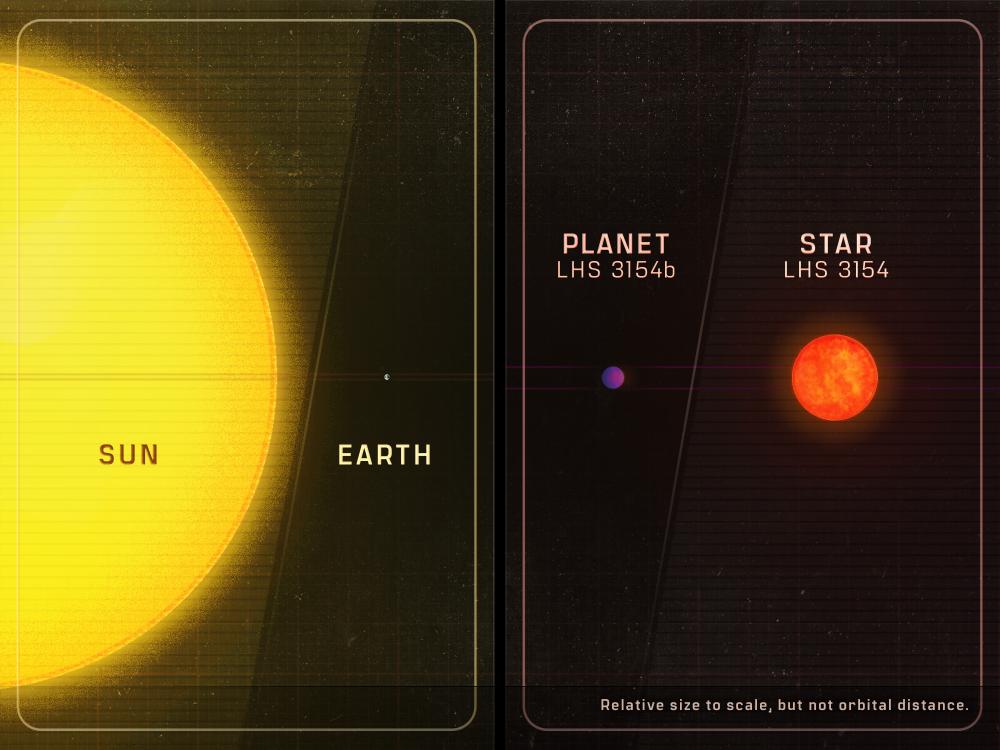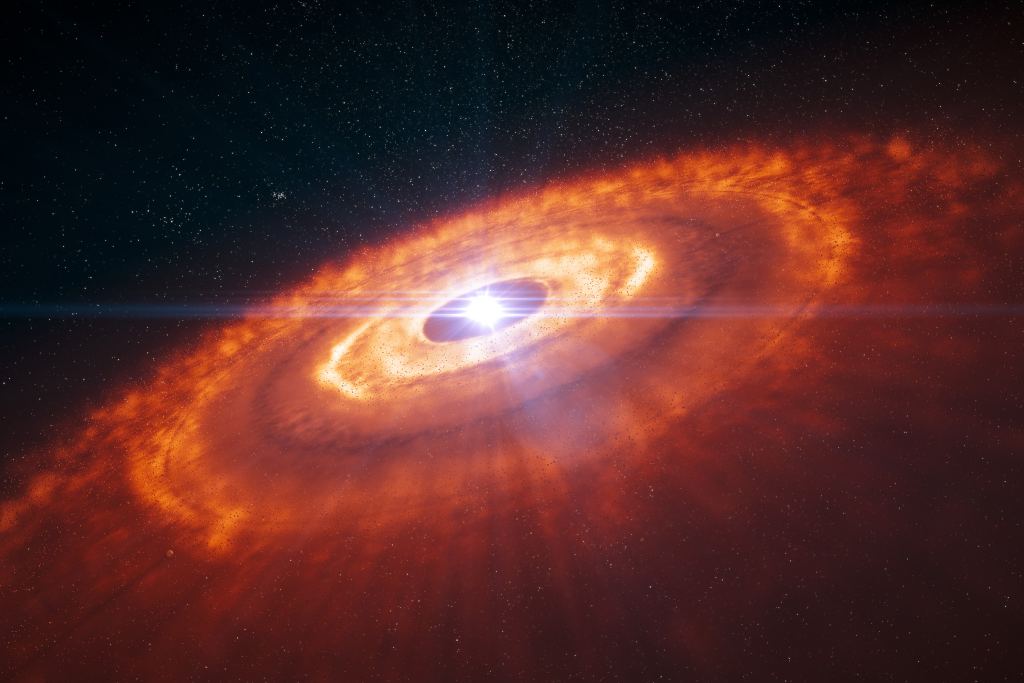Scientists love outliers. Outliers are nature's way of telling us what its boundaries are and where its limits lie. Rather than being upset when an outlier disrupts their understanding, scientists feed on the curiosity that outliers inspire.
It's true in the case of a new discovery of a massive planet orbiting a small star. That goes against our understanding of how planets form, meaning our planet-formation model needs an update.
In a paper published in Science, researchers announced the discovery of a Neptune-mass exoplanet orbiting a low-mass star. The star is LHS 3154, an M-dwarf, or red dwarf star. It's only 0.11 times as massive as the Sun, which is a normal mass for a red dwarf.
But what's surprising is the size of the planet orbiting the star. The planet is called LHS 3154b, and it's a monster compared to most planets orbiting red dwarfs. It has at least 13.2 Earth masses. That places it in the same range as Neptune, which has 17 Earth masses. LHS 3154b is also in a very close orbit, taking only 3.7 days to orbit the star.
"This discovery really drives home the point of just how little we know about the universe."Suvrath Mahadevan, Penn State University
The new paper is " A Neptune-mass exoplanet in close orbit around a very low-mass star challenges formation models. " The lead author is Gudmundur Stefansson, NASA Sagan Fellow in Astrophysics at Princeton University. Stefansson was a graduate student at Penn State while working on this discovery.
"This discovery really drives home the point of just how little we know about the universe," said Suvrath Mahadevan, a Professor of Astronomy and Astrophysics at Penn State and co-author of the paper. "We wouldn't expect a planet this heavy around such a low-mass star to exist."
Why is this discovery surprising? It's all about stars and their protoplanetary disks.
When a star forms, it starts as a protostar in the center of a solar nebula. As the star forms, a rotating disk of gas and dust called a protoplanetary disk forms around the star. Dense knots form in the disk, and this is how planets and planetesimals form. It's a detailed process and one we don't entirely understand. But what scientists do know, or thought they knew, is that the more mass there is in the disk, the more massive the planets that can form. And the mass in the disk scales steeply with the mass of the star.
It looks like this: massive star = massive disk = massive planets. Naturally, we consider the obverse to be true, too. Small star = small disk = small planets. But LHS 3154b and its star don't conform to this. There simply shouldn't have been enough mass in the protoplanetary disk for the planet to form.
"The planet-forming disk around the low-mass star LHS 3154 is not expected to have enough solid mass to make this planet," Mahadevan said. "But it's out there, so now we need to reexamine our understanding of how planets and stars form."
It took a special instrument to spot the massive planet, and Mahadevan led the team of scientists that built it. It's called the Habitable Zone Planet Finder or HPF, a spectrograph built at Penn State. HPF is designed to detect planets orbiting cool stars that might have liquid surface water. Small planets can be very difficult to detect around large, bright stars like our Sun because the Sun's light overpowers everything else.
But around smaller cooler stars, planets close enough to have liquid water are much easier to find.
"Think about it like the star is a campfire. The more the fire cools down, the closer you'll need to get to that fire to stay warm," Mahadevan said. "The same is true for planets. If the star is colder, then a planet will need to be closer to that star if it is going to be warm enough to contain liquid water. If a planet has a close enough orbit to its ultracool star, we can detect it by seeing a very subtle change in the colour of the star's spectra or light as it is tugged on by an orbiting planet."
LHS 3154 is one of the smallest stars ever found. It has only 11% of the mass of the Sun, and a star needs to have 8% of the Sun's mass to maintain fusion. It's called a VLM star or Very Low Mass star. Stars like LHS 3154 are hard to spot because they're so small and so dim. For that reason, there aren't very many VLM stars in exoplanet surveys.
But astronomers designed the HPF with this is mind. The team of researchers behind this work started observing LHS 3154 with HPF back in 2020. They quickly found signs of a planet around the star, tugging slightly on the star and giving it the telltale wobble that can signal the presence of a planet. But M-dwarfs are known to flare quite a bit which can be a false positive, so the astronomers watched for a while. Once they saw that the signal was constant, they knew they'd found a planet.
M-dwarfs are known to host lots of planets, but they're typically much smaller than the huge planets we see in our Solar System and around other stars similar to our Sun. LHS 3154b is rare, an outlier, and that means there's work to do explaining how it formed there.
"Based on current survey work with the HPF and other instruments, an object like the one we discovered is likely extremely rare, so detecting it has been really exciting," said Megan Delamer, astronomy graduate student at Penn State and co-author on the paper. "Our current theories of planet formation have trouble accounting for what we're seeing."
LHS 3154b should have a heavy planetary core, according to the team's measurements. But current models predict that the protoplanetary disk should not have had enough material for it to form. A protoplanetary disk contains both gas and dust. The ratio between the two helps explain what mass the star will have and what masses the planets will have. The existence of LHS 3154 b around the M-dwarf suggests that the dust-to-gas ratio of the disk needs to be ten times higher than how scientists understand it.
There are two theories of how planets form. One is the core-accretion theory, where matter forms a clump which accumulates more and more matter until a planetary core is formed. The other is the gravitational instability model. It explains how massive planets form in massive disks. Rather than accretion by pebbles, gas collapses gravitationally in the disk to eventually form gas giants like Jupiter and Saturn.
The team performed multiple simulations to test these theories against their findings. Simulations of the core-accretion mechanism couldn't produce any planets as massive as LHS 3154b, and simulations of the gravitational collapse mechanism couldn't produce any planets as small as LHS 3154b.
"Both potential formation mechanisms require protoplanetary disks that have substantially greater dust masses than are typically observed around very low-mass stars," the team writes in their paper.
In their paper, the authors discuss some possible explanations.
It's possible that protoplanetary disks, at least in some cases, can still accumulate matter from the molecular cloud that the star formed from. So there's basically another reservoir of material for planets to form from. That's one potential explanation.
Or it's possible that protoplanetary cores form sooner than thought, within 1 million years after the host protostar. At that young age, protoplanetary disks are expected to be more massive than at later times. That could allow enough material to accrete rapidly, forming a gas giant.
A third possibility is that we're not accurately seeing what's going on. If dust grows into large pebbles around a star, infrared observations can struggle to see it. "... pebbles of that size would not be detected by the millimetre observations used to estimate the overall dust masses, causing them to underestimate," the researchers explain.
Whatever the eventual explanation is, the discovery shows that the HPF is doing what it was built to do. If it can find more of these outliers, we'll be on our way to figuring out more important details of the planet-forming process.
"What we have discovered provides an extreme test case for all existing planet formation theories," Mahadevan said. "This is exactly what we built HPF to do, to discover how the most common stars in our galaxy form planets — and to find those planets."
"Making the discovery with HPF was extra special, as it is a new instrument that we designed, developed and built from the ground-up for the purpose of looking at the uncharted planet population around the lowest mass stars," said Guðmundur Stefánsson, NASA Sagan Fellow in Astrophysics at Princeton University and lead author on the paper. Stefánsson also helped develop HPF and worked on the study as a graduate student at Penn State. "Now we are reaping the rewards, learning new and unexpected aspects of this exciting population of planets orbiting some of the most nearby stars."
 Universe Today
Universe Today



